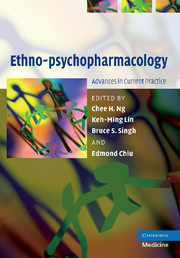Book contents
- Frontmatter
- Contents
- List of figures
- List of tables
- List of contributors
- Foreword
- Acknowledgments
- 1 Introduction
- 2 Culture and psychopathology
- 3 Culture and ethnicity in psychopharmacotherapy
- 4 Ethnic differences in psychotropic drug response and pharmacokinetics
- 5 Pharmacogenetics of ethnic populations
- 6 Variation in psychotropic responses in the Chinese population
- 7 Variation in psychotropic responses in the Hispanic population
- 8 Identifying inter-ethnic variations in psychotropic response in African Americans and other ethnic minorities
- 9 Complementary medicines in mental disorders
- 10 Cultural factors and the use of psychotropic medications
- 11 Outpatient prescribing practices in Asian countries
- 12 Psychiatric inpatient psychotropic prescribing in East Asia
- 13 Pharmaco-economic implications for Asia and other economically disadvantaged countries
- 14 Integrating theory, practice and economics in psychopharmacology
- 15 Research directions in ethno-psychopharmacology
- Index
- References
11 - Outpatient prescribing practices in Asian countries
Published online by Cambridge University Press: 22 August 2009
- Frontmatter
- Contents
- List of figures
- List of tables
- List of contributors
- Foreword
- Acknowledgments
- 1 Introduction
- 2 Culture and psychopathology
- 3 Culture and ethnicity in psychopharmacotherapy
- 4 Ethnic differences in psychotropic drug response and pharmacokinetics
- 5 Pharmacogenetics of ethnic populations
- 6 Variation in psychotropic responses in the Chinese population
- 7 Variation in psychotropic responses in the Hispanic population
- 8 Identifying inter-ethnic variations in psychotropic response in African Americans and other ethnic minorities
- 9 Complementary medicines in mental disorders
- 10 Cultural factors and the use of psychotropic medications
- 11 Outpatient prescribing practices in Asian countries
- 12 Psychiatric inpatient psychotropic prescribing in East Asia
- 13 Pharmaco-economic implications for Asia and other economically disadvantaged countries
- 14 Integrating theory, practice and economics in psychopharmacology
- 15 Research directions in ethno-psychopharmacology
- Index
- References
Summary
Introduction
Every country has its differences in the characteristics of psychiatric practice including those relating to prescribing psychotropic drugs. In Asian countries only limited data is available. Most of the earlier data involved Asian refugees or Asian patients born in Western countries and the results were also inconsistent (Bond, 1991). However, Asia covers a large geographical area and diverse populations with different physical features, cultural backgrounds, and dietary habits. The socioeconomic differences in Asian countries also have implications on the number of psychiatrists and mental health workers, and infrastructure for mental health services. A review of outpatients prescribing patterns hence can add to our understanding of important systemic and cultural determinants of psychotropic prescription in the management of major mental disorders. Furthermore, prescribing practice in outpatients services are reflective of real-life clinical settings and long-term exposure to psychotropics affecting patients.
Antipsychotics prescribing
Reports on prescribing psychotropic practice have mostly comprised antipsychotics in the treatment of schizophrenia and major psychoses. Studies can be broadly divided into “self-reported” questionnaires of prescribing habit or “revealed” data of actual prescription via for example an audit of psychotropic drug usage. An example of the former comes from a questionnaire given to practicing Asian psychiatrists after reading a case vignette of a 28-year-old unmarried businessman with a first episode of paranoid schizophrenia (Udomratn, 1999). The average daily dose of haloperidol that would be prescribed following the first week in the absence of any serious side effects was compared between psychiatrists across Asia.
- Type
- Chapter
- Information
- Ethno-psychopharmacologyAdvances in Current Practice, pp. 135 - 143Publisher: Cambridge University PressPrint publication year: 2008
References
- 2
- Cited by



